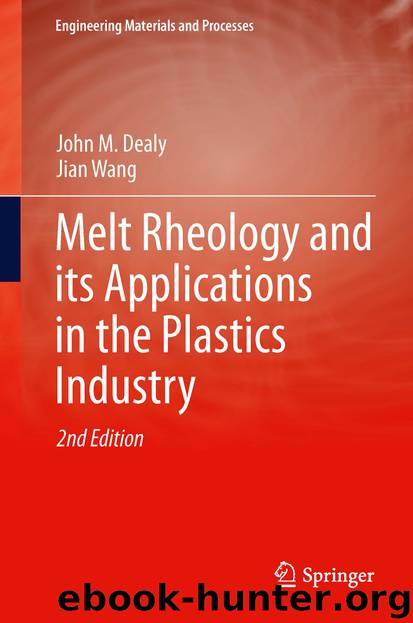Melt Rheology and its Applications in the Plastics Industry by John M. Dealy & Jian Wang

Author:John M. Dealy & Jian Wang
Language: eng
Format: epub
Publisher: Springer Netherlands, Dordrecht
Whenever possible, calibration should be based on the measurement of basic quantities such as torque and angular displacement. Scatter in results from several tests arise mainly from variations in gap spacing, sample trimming and temperature. Round-robin tests have revealed that variability from one laboratory to another is much higher than that within a laboratory, probably due to differences in test procedure and equipment. When establishing the limiting strain amplitude for linear behavior, it is important to realize that this depends on frequency.
Two types of motor-drive are available. In controlled-strain or controlled rate (CR) instruments a motor rotates one fixture, while torque and normal force transducers are coupled to the stationary fixture. In controlled-stress (CS) instruments, the rotating fixture is driven by a motor designed to generate a prescribed torque. Thus, torque determination and motion generation are combined. A detailed discussion of the differences between these two types of instrument is available [4].
For many years, controlled-strain (CR) units made use of DC motors in which commutation was by means of brushes, while brushless (electrically commutated, EC) motors were later introduced. An optical encoder is generally used to track rotary displacement, the signal from which goes to a closed-loop control motor control system. The compliance of the body and rotor shaft causes a mismatch between the encoder output and the deformation experienced by the sample, and the force balance transducer was developed to deal with this problem. A description and sketch of the FBT can be found in [5, p. 344]. A drag cup motor applies a torque to balance that driving compliance, and the motor current is proportional to the torque. This device adds its own time constant to the system.
With drag cup motors, the time required for the fields to build up limits their use at high frequencies and for generating large amplitude oscillatory motion. Air-bearing supported EC (brushless DC) motors are now used in some CS rheometers, and this means that the stator torque follows the stator current almost instantaneously. Using an optical encoder indication of the strain or rate in a feedback loop makes it possible to operate in a controlled strain or rate mode.
CR units are suitable for oscillatory shear at moderate to high frequencies and steady shear, including start-up of steady shear, and for the measurement of viscosity and first normal stress difference. CS instruments are advantageous for creep and recoil, especially when very low strain rates are needed to probe the terminal region.
For creep and recovery tests, it is very important to minimize friction, as this introduces an error in the torque signal. This is especially crucial for creep recovery (elastic recoil) as this requires that the torque be suddenly reduced to zero, and this is virtually impossible to achieve with an air bearing due to the small torque resulting from the air flow. Magnetic bearings can eliminate this residual torque.
The equations used to calculate stress and strain in cone-plate and parallel plate rheometers are based on the following assumptions:1.Inertia can be neglected because of the high viscosity of melts.
Download
This site does not store any files on its server. We only index and link to content provided by other sites. Please contact the content providers to delete copyright contents if any and email us, we'll remove relevant links or contents immediately.
| Concrete | Extraction & Processing |
| Fracture Mechanics | Materials Science |
| Metallurgy | Polymers & Textiles |
| Strength of Materials | Testing |
Whiskies Galore by Ian Buxton(41722)
Introduction to Aircraft Design (Cambridge Aerospace Series) by John P. Fielding(33019)
Small Unmanned Fixed-wing Aircraft Design by Andrew J. Keane Andras Sobester James P. Scanlan & András Sóbester & James P. Scanlan(32687)
Craft Beer for the Homebrewer by Michael Agnew(18084)
Turbulence by E. J. Noyes(7897)
The Complete Stick Figure Physics Tutorials by Allen Sarah(7269)
Kaplan MCAT General Chemistry Review by Kaplan(6825)
The Thirst by Nesbo Jo(6765)
Bad Blood by John Carreyrou(6479)
Modelling of Convective Heat and Mass Transfer in Rotating Flows by Igor V. Shevchuk(6356)
Learning SQL by Alan Beaulieu(6162)
Weapons of Math Destruction by Cathy O'Neil(6087)
Man-made Catastrophes and Risk Information Concealment by Dmitry Chernov & Didier Sornette(5880)
Digital Minimalism by Cal Newport;(5590)
Life 3.0: Being Human in the Age of Artificial Intelligence by Tegmark Max(5407)
iGen by Jean M. Twenge(5330)
Secrets of Antigravity Propulsion: Tesla, UFOs, and Classified Aerospace Technology by Ph.D. Paul A. Laviolette(5241)
Design of Trajectory Optimization Approach for Space Maneuver Vehicle Skip Entry Problems by Runqi Chai & Al Savvaris & Antonios Tsourdos & Senchun Chai(4959)
Electronic Devices & Circuits by Jacob Millman & Christos C. Halkias(4869)
